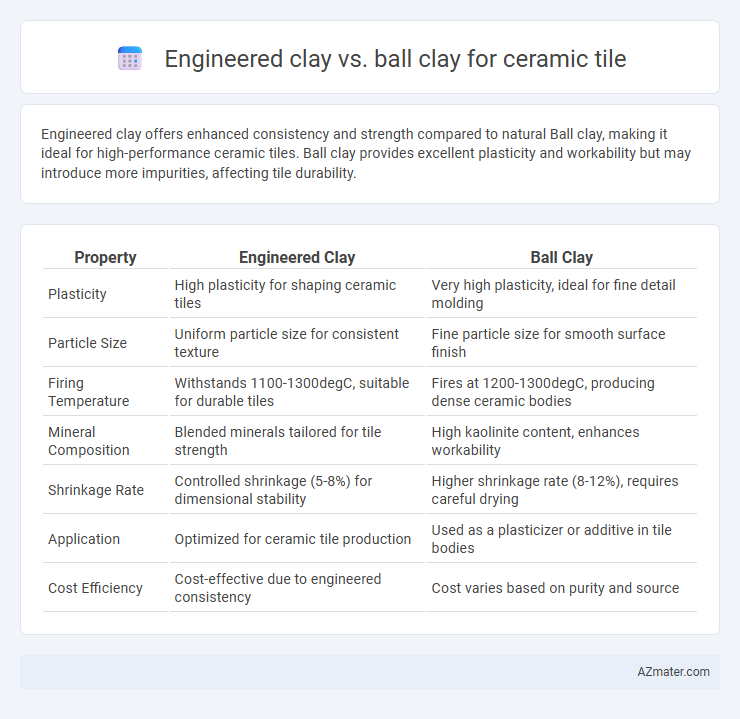Engineered clay offers enhanced consistency and strength compared to natural Ball clay, making it ideal for high-performance ceramic tiles. Ball clay provides excellent plasticity and workability but may introduce more impurities, affecting tile durability.
Table of Comparison
| Property | Engineered Clay | Ball Clay |
|---|---|---|
| Plasticity | High plasticity for shaping ceramic tiles | Very high plasticity, ideal for fine detail molding |
| Particle Size | Uniform particle size for consistent texture | Fine particle size for smooth surface finish |
| Firing Temperature | Withstands 1100-1300degC, suitable for durable tiles | Fires at 1200-1300degC, producing dense ceramic bodies |
| Mineral Composition | Blended minerals tailored for tile strength | High kaolinite content, enhances workability |
| Shrinkage Rate | Controlled shrinkage (5-8%) for dimensional stability | Higher shrinkage rate (8-12%), requires careful drying |
| Application | Optimized for ceramic tile production | Used as a plasticizer or additive in tile bodies |
| Cost Efficiency | Cost-effective due to engineered consistency | Cost varies based on purity and source |
Introduction to Engineered Clay and Ball Clay
Engineered clay is a specially formulated blend designed to enhance the performance and consistency of ceramic tiles, offering improved plasticity, strength, and fired density compared to natural clays. Ball clay is a highly plastic, fine-grained natural clay primarily used in ceramic tile production for its binding properties and ability to improve workability and green strength. Both engineered clay and ball clay play critical roles in optimizing tile body composition, with engineered clay providing tailored characteristics while ball clay contributes essential plasticity and firing behavior.
Key Properties of Engineered Clay
Engineered clay for ceramic tiles offers superior consistency in particle size distribution and mineral composition compared to ball clay, resulting in enhanced plasticity and workability during tile forming. Its controlled chemical and physical properties reduce shrinkage and improve drying behavior, minimizing warping and cracking in the final product. Engineered clay's optimized strength and firing characteristics contribute to higher durability and uniformity in ceramic tiles.
Characteristics of Ball Clay
Ball clay is a highly plastic, fine-grained sedimentary clay known for its excellent workability and smooth texture, making it ideal for ceramic tile bodies. It contains high levels of kaolinite, mica, and quartz, which contribute to its plasticity and strength after firing, enhancing the durability and surface finish of ceramic tiles. Compared to engineered clay, ball clay offers superior bonding properties and plasticity, resulting in better moldability and reduced shrinkage during drying and firing processes.
Raw Material Composition: A Comparative Overview
Engineered clay for ceramic tiles typically contains a balanced blend of kaolinite, silica, and feldspar, offering controlled plasticity and firing properties, while ball clay is rich in kaolinite and organic matter, providing superior plasticity but higher shrinkage. The mineralogical composition of engineered clay allows for enhanced strength and reduced warping during tile production compared to the highly plastic, finer-grained ball clay. Understanding these compositional differences helps manufacturers select raw materials that optimize final tile durability and aesthetic quality.
Workability and Plasticity in Tile Production
Engineered clay offers consistent plasticity and enhanced workability, enabling precise control over molding and shaping in ceramic tile production. Ball clay, known for its high plasticity due to fine particle size and mineral composition, improves tile plasticity but can vary in quality, affecting processing stability. Selecting engineered clay optimizes uniformity in tile forming, while ball clay contributes to plasticity but may require blending for consistent workability.
Impact on Tile Strength and Durability
Engineered clay offers enhanced consistency and controlled particle size, resulting in ceramic tiles with improved mechanical strength and reduced porosity compared to ball clay. Ball clay, known for its plasticity and fine particle distribution, contributes to tile flexibility but may increase water absorption, potentially affecting long-term durability. Selecting engineered clay in tile manufacturing optimizes structural integrity and wear resistance, leading to longer-lasting ceramic products.
Firing Behavior and Sintering Differences
Engineered clay offers controlled particle size distribution and composition, leading to more uniform firing behavior compared to ball clay, which contains higher impurities and organic content resulting in variable shrinkage and sintering rates. During firing, engineered clay achieves consistent densification at lower temperatures due to optimized mineralogy, whereas ball clay typically requires extended firing cycles to reach similar sintering levels, often causing increased warping or deformation. The precise mineral control in engineered clay improves vitrification and mechanical strength of ceramic tiles, while ball clay's natural variability can compromise tile durability and surface quality.
Color and Finish Outcomes
Engineered clay offers greater consistency in color and a smoother finish for ceramic tiles, allowing precise control over hue and surface texture. Ball clay provides excellent plasticity and bonding properties but can result in less uniform color and a more textured surface due to its natural mineral variations. Manufacturers often blend engineered clay with ball clay to optimize both color uniformity and finish quality in ceramic tile production.
Cost Efficiency and Availability
Engineered clay offers consistent quality and tailored properties, making it cost-efficient for large-scale ceramic tile production due to reduced waste and lower processing times compared to ball clay. Ball clay, while often more affordable per unit, can vary in composition and requires more extensive processing, increasing overall manufacturing costs and time. Availability of engineered clay is typically more controlled and reliable, whereas ball clay's supply may fluctuate seasonally or regionally, impacting production stability.
Environmental Considerations and Sustainability
Engineered clay for ceramic tiles typically offers enhanced sustainability due to controlled sourcing and reduced mining impact compared to ball clay, which often involves intensive extraction processes that can lead to significant land degradation. Engineered clay formulations can incorporate recycled materials and optimize raw material usage, minimizing waste and lowering carbon footprints in tile production. Ball clay, while providing desirable plasticity and strength, poses greater environmental concerns from habitat disruption and higher energy consumption during processing.

Infographic: Engineered clay vs Ball clay for Ceramic tile
 azmater.com
azmater.com